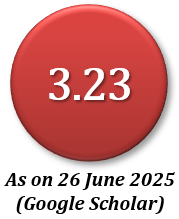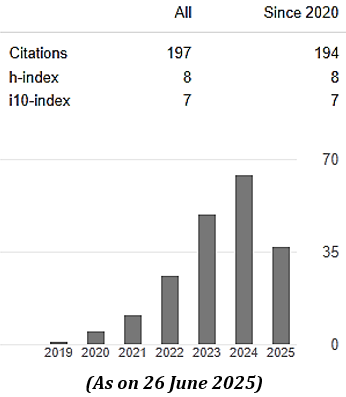RANS Flow Computation around Transonic RAE2822 Airfoil with a New SST Turbulence Model
Abstract
The solution to RANS (Reynolds-averaged Navier-Stokes) equations invokes a suitable framework for turbulence modelling. To account for turbulence and transition effects, a new SST (Shear Stress Transport) k-ω turbulence model is coupled with RANS to simulate the transonic flow passing an RAE2822 air foil. Three sets of experimental data of the super-critical RAE2822 air foil are employed to validate the new SST (NSST) closure. Computations are conducted for a limited range of Reynolds numbers with variable angle of attack. The NSST model has been found to replicate satisfactory results for lift CL and drag CD coefficients as well as for skin-friction and pressure coefficient profiles under considerable shock-wave boundary layer (BL) interaction, although CD is challenging to be accurately predicted since the turbulence model requires to adequately resolve near-wall turbulence in the BL with varying pressure gradients. NSST predictions are compared with those of the widely-used SST k-ω model. Numerical outputs demonstrate that the included NSST transition model plays no significant roles to appropriately predict CL and CD, indicating that the NSST performance is almost equivalent to that of the SST in the current analysis.
Downloads
References
Cook, P. H., M. A. McDonald, M. C. P. Firmin, Aerofoil RAE 2822 - Pressure Distributions, and Boundary Layer and Wake Measurements, in RAE2822 Transonic Airfoil, J.W. Slater, Editor. 1979: NASA.
Da Ronch, A., et al., Sensitivity and calibration of turbulence model in presence of epistemic uncertainties. CEAS Aeronautical Journal, 2019. 11 doi: 10.1007/s13272-019-00389-y.
Hellsten, A. and S. Laine, Extension of k- W Shear-Stress Transport Turbulence Model for Rough-Wall Flows. AIAA Journal, 1998. 36(9): p. 1728-1729 doi: 10.2514/2.7543.
Lien, F.-S., G. Kalitzin, and P. Durbin, RANS modeling for compressible and transitional flows. Proceedings of the Summer Program, 1998.
Menter, F., et al., A Correlation-Based Transition Model Using Local Variables—Part I: Model Formulation. ASME J. Turbomach, 2006. 128 doi: 10.1115/1.2184352.
Menter, F. R., Two-equation eddy-viscosity turbulence models for engineering applications. AIAA Journal, 1994. 32(8): p. 1598-1605 doi: 10.2514/3.12149.
Mundell, A. R. G. and D. G. Mabey, Pressure fluctuations caused by transonic shock/boundary-layer interaction. The Aeronautical Journal, 2016. 90(897): p. 274-282 doi: 10.1017/S0001924000015864.
Radespiel, R., A cell-vertex multigrid method for the Navier-Stokes equations. 1989.
Rumsey, C. L. and V. N. Vatsa, Comparison of the predictive capabilities of several turbulence models. Journal of Aircraft, 1995. 32(3): p. 510-514 doi: 10.2514/3.46749.
Rahman, M. M., Capturing transition and non-transition flows with a new shear stress transport model. Chinese Journal of Aeronautics, 2023. 36(3): p. 121-136 doi: https://doi.org/10.1016/j.cja.2022.08.013.
Rahman, M. M., Predicting transition with wall-distance-free SST k-ω model. Computers & Fluids, 2023. 250: p. 105704 doi: https://doi.org/10.1016/j.compfluid.2022.105704.
Rahman, M. and Siikonen, T. An Artificial Compressibility Method for Incompressible Flows. Numerical Heat Transfer Part B - Fundamentals, 2001. 40 doi: 10.1080/104077901753243188.
Rahman, M. M. and Siikonen, T. A Dual-Dissipation Scheme for Pressure-Velocity Coupling. Numerical Heat Transfer, Part B: Fundamentals, 2002. 42(3): p. 231-242 DOI: 10.1080/10407790260233547.
Rahman, M. M. and Siikonen, T. An artificial compressibility method for viscous incompressible and low Mach number flows. International Journal for Numerical Methods in Engineering, 2008. 75(11): p. 1320-1340 doi: https://doi.org/10.1002/nme.2302.
Rahman, M. M., Compromising with corrector step of SIMPLE Algorithm. Mathematics and Computers in Simulation, 2021. 188: p. 135-163 doi: https://doi.org/10.1016/j.matcom.2021.03.043.
Rahman, M., Rautaheimo, P., and Siikonen, T. Numerical Study of Turbulent Heat Transfer from Confined Impinging Jets Using a Pseudo-compressibility, Method. 1997.
Schwamborn D. 1991: Validation of 2D Navier-Stokes codes with respect to turbulence modelling. Progress report for the third half-year of the EUROVAL project, part It: RAE 2822 test cases, Institutfur Theoretische Stromungsmechanik, Gottingen, IB 221-91 A 27.
Singh, J. P., An improved Navier-Stokes flow computation of AGARD case-10 flow over RAE2822 airfoil using Baldwin-Lomax model. Acta Mechanica, 2001. 151(3): p. 255-263 doi: 10.1007/BF01246922
Slater J. W. RAE2822 Transonic Airfoil: Study #1, NASA Glenn Research Centre, Ohio. http://www.grc.nasa.gov/WWW/wind/valid/raetaf/raetaf01/raetaf01.html
MIJST follows the open access policy.

This work is licensed under a Creative Commons Attribution-NonCommercial 4.0 International License. This allows anyone to copy, share, distribute, and modify the work for non-commercial purposes, where the original work and source should be properly credited.
















